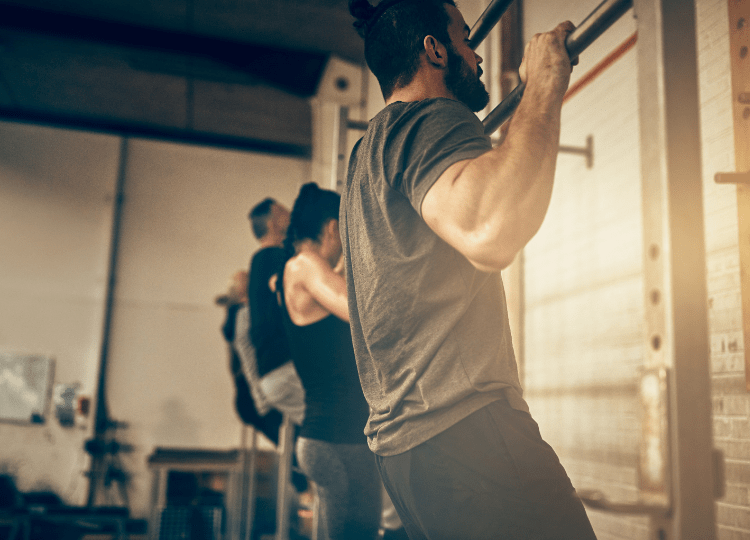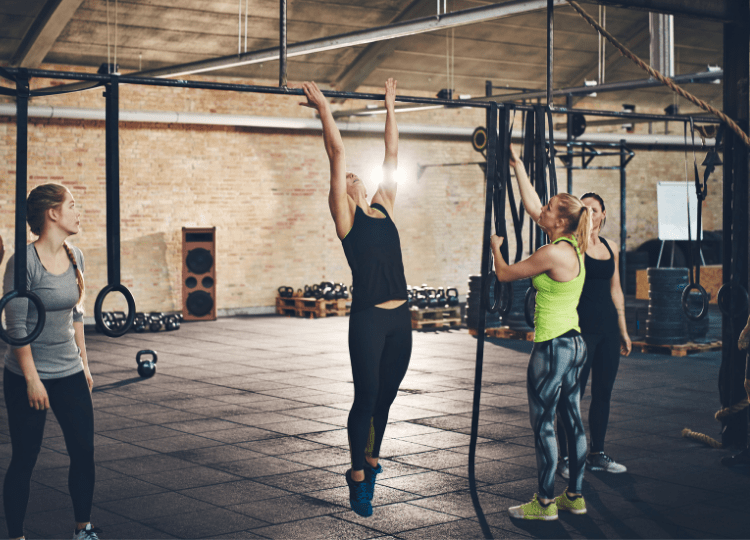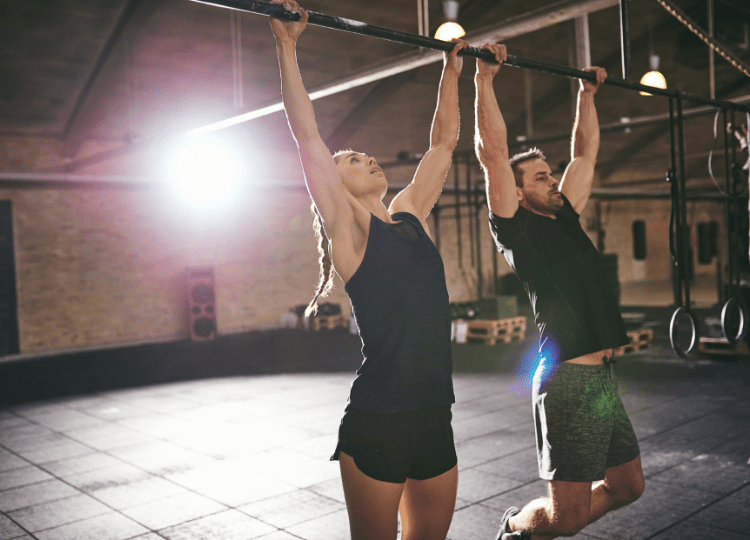If you’ve always wanted to master the humble pull up but never quite achieved it, you’ll want to keep reading because this article outlines the perfect way to get started with pull ups and how to slowly add progression to the exercise until you can do a full pull up by yourself.
Pulls are a fantastic upper body exercise that help build functional strength in the arms, shoulders, back and core – but the problem for many is the fact that they are undoubtedly a tricky exercise to get started with.
Until now…. until you discover this clever way to get your body primed for tackling a full pull up.
The answer lies with a simple yet powerful concept in fitness, known as eccentric training. Eccentric refers to the “lowering” part of a movement, as opposed to the contraction or lifting part. In relation to pull ups, this means doing eccentric variations, also known as “negative pull ups.”
These eccentric pull up variations help your muscles get used to the movement and prepared for supporting your body’s weight. They are a proven way to help build the strength needed to get started with pull ups.
In this handy guide, we outline everything you need to know about negative pulls, including how to do them, the benefits, muscles worked and tips for getting the most out of them.

How to do Negative Pull Ups
Starting Position
The starting position of a negative pull up is when your chin is above the bar.
There are various ways you could get into this position. If you are using negative pulls as a progression from regular push ups (i.e. you’re using a slow lowering movement to add difficulty), you can just do a regular pull up to get into the starting position. If however, you’re using negative pull ups as a way to get started with pull ups, you could use a spotter to help lift you up, a gym box or bench to raise you up, or a resistance band to help propel you upwards.
Hold the bar with both hands, roughly shoulder width apart, keep your head and chest up. Engage your core, lats and arms, whilst squeezing your shoulder blades to create stability during this starting position.
Slowly Lower Yourself Down
This is the focus of the exercise. Slowly lower yourself down, over a duration of 3-8 seconds. The slower you lower yourself, the harder it will be.
You should be in control at all times, avoiding any sudden drops or jerking movements.
Lower yourself down until your arms are straight.

Hold for a Moment
At this point in the exericse, you are in a Dead Hang pose. Hold this for a moment for additional benefit. This will keep the lats and core engaged for longer, forcing the muscles to work harder.
This can be seen as the end of the first repetition.
Propel Yourself Up to the Starting Position
To do more than one repetition, you need to get back to the starting position.
This can be the same way as you got into the initial starting position, whether that was by a spotter helping to lift you, using a gym box/bench or a resistance band.
If you don’t have access to a workout buddy, bench/gym box or band, you could also jump into the starting position. This would be more challenging, but easier than doing the concentric part of a regular pull up.
Coach’s Tip – If you use a resistance band, you can start off using a thicker band and over time integrate thinner, lighter bands. This will slowly allow you to progress into regular pull ups.
Benefits of Negative Pull Ups
Beginner Friendly
One of the obvious benefits of negative pulls is that they are a great way to get started with pull ups. They allow you to practice and improve the movement of a pull up, without needing the strength to lift your weight up.
You are working with gravity, as opposed to against gravity, making the lowering part of a pull up easier than the concentric part.
Negative pull ups provide the perfect stepping stone to see improvement, until you are able to do a full pull up.
Variation
The benefits of “negative reps” is that the concept works for whichever pull up grip you prefer. Whether you want to do “chin ups” using a reverse grip or stick to the regular overhand grip, the benefits of doing slow lowering movements remains the same.
Strengthen Your Grip
Negative pull ups require a strong grip for the whole movement. Without it, you’d simply let go of the bar. This improved grip strength isn’t to be underestimated and can be of immense benefit for other exercises and daily activities.

Build a Stronger Back
Although negative pull ups are often seen as a way to progress and improve your regular pull up, they are still incredibly effective at building a stronger back. In fact, the lowering part of the movement is where a lot of the muscle tissue microdamage occurs, being replaced by stronger, thicker muscle.
Core Stability
Lowering yourself slowly will require your core to be engaged to ensure you are balanced and stable during the movement.
The slower you go, the more your core will have to work.
This is a great benefit of negative pull ups, or more broadly, pull ups in general, that many people forget about.
Eccentric Training
Negative pull ups bring with them all the benefits of eccentric training. Our recent blog on negative bicep curls highlights the same benefits of eccentric training for bicep curls.
Eccentric training is a great way to build muscle and strength, due to putting the muscles under increased resistance for longer. Many studies have shown that the eccentric phase of a movement, whereby the muscle is lengthening, is the more efficient way of building strength.
Muscles Worked During Negative Pull Ups
Negative pull ups primarily work the lats. The biceps, forearms, shoulders and core are also engaged during the movement.
Depending on your hand position and grip, you can put more emphasis on the biceps/arms, or more on the lats/back (e.g. a chin up grip would target the biceps more than a traditional overhand grip).
Weighted Negative Pull Ups
If you’re looking to add difficulty, using a weighted vest is a simple yet effective way to enhance your negative reps.
This will create extra weight that your muscles will need to accommodate for, forcing them to work harder.
This is a popular way to add progression and difficulty to the movement.
Another option is to use a dumbbell for extra weight. For this variation, hold a dumbbell between your feet as you lower yourself down.
Negative Pull Ups vs Assisted Pull Ups
Negative pull ups are similar to assisted pull ups but there are some key differences.
Negative pull ups focus on the eccentric or lowering phase of the movement.
Assisted pull ups, however, describe any type of equipment or technique used to help make pull ups easier. For example, many gyms have assisted pull up machines, that take some of the weight during both the lifting and lowering of the movement. This isn’t the same as a negative rep, as the machine is supporting you during the lowering phase too.
You may want to start with assisted pull ups to begin with, and then try negative reps once you’ve built up some confidence.
Negative Pull Ups Vs Pull Ups
Negative pull ups boast some impressive benefits, largely due to the concept of eccentic training. Nevertheless, for best results, it’s still useful to include both eccentric and concentric movements into your workout routines.
This means including full pull ups in your routine is still worth doing… once you’ve built up enough strength to do the full movement.
Negative Pull Up Alternatives
Dead Hang
If you find negative pull ups too challenging, try starting with Dead Hangs.
Dead Hangs involve holding a bar with your arms straight (i.e. the bottom phase of a pull up). Your lats, core and arms will still need to be engaged, as you hold onto the bar. This will help train your muscles in getting used to this sort of movement.
Once you feel comfortable with a Dead Hang, you can try holding them for longer and longer.
Dead Hangs are particularly effective at helping to develop better grip strength.
Body Row
Body Rows are like mini pull ups, but still pack a punch in terms of benefits.
To perform a Body Row, set a bar roughly waist height and lay underneath it, with your shoulders directly under the bar. Keeping your feet on the floor, grab the bar and pull your chest to the bar. You could do a negative body row by slowly lowering yourself back down.
Are Negative Pull Ups Good?
Negative pull ups are a great way to build strength in your back, arms and core, as well as helping provide a practical way to get started with pull ups.
Negative pull ups are a popular and effective way to progress your way to full pull ups.
They also benefit from eccentric training, which helps to develop muscle and strength.
Related Articles
